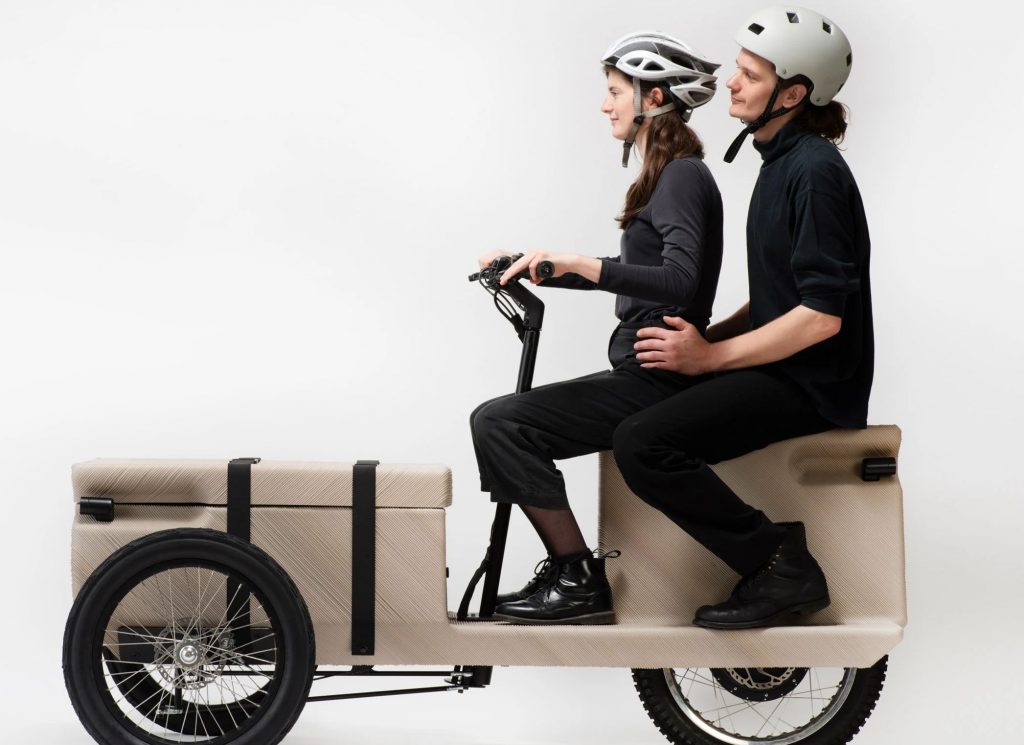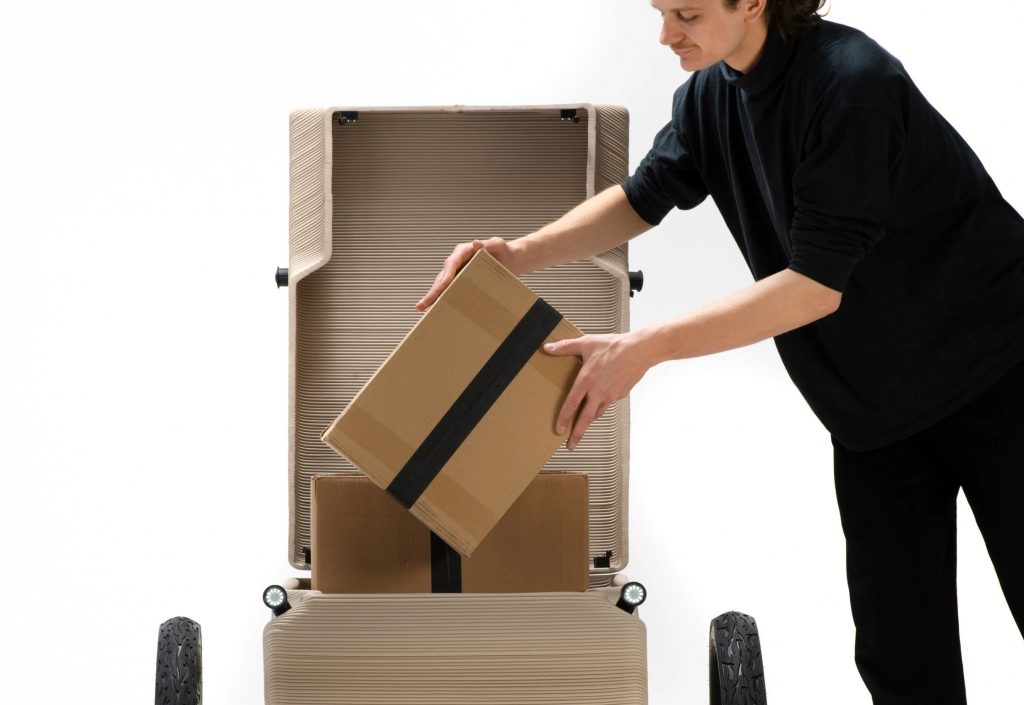The nominations for the 2021 3D Printing Industry Awards are now open. Who do you think should make the shortlist for this year’s show? Have your say now.
Austrian design studio EOOS has recycled polymeric waste into a unique electric tricycle, with the aim of deploying it in bustling cities to help reduce carbon emissions around the world.
Made from repurposed supermarket plastics, the firm’s ‘Zero-Emissions Utility Vehicle’ or ‘ZUV,’ features a 3D printed polypropylene (PP) chassis as well as a handlebar and small electric motor. If unleashed on the streets, the trike’s designers say that it could represent both an economical mode of transport for commuters, and an eco-friendly use of polymeric packaging, that’s usually burnt by retailers.
“When supermarket plastic in Vienna goes to recycling, they’re just burning it, and this creates another three tonnes of CO2 emissions,” EOOS founder Harald Gründl explained to Dezeen. “The reuse of post-consumer plastics is a big step towards net-zero carbon emissions. Every new vehicle will be, in a way, carbon neutral as long as the 3D printer is operated with energy coming from renewables.”
“It’s way easier to close the [circularity] loop if you [recycle] locally rather than sending around ships full of waste as we do today, which is stupid.”

Prototyping an eco-friendly ‘ZUV’
Built in collaboration with experienced Dutch studio, The New Raw, the ZUV sports a deliberately-simplified design, in order to make its construction as economical as possible. During the vehicle’s production, the firms leveraged The New Raw’s in-house robotics-based technology to 3D print its chassis in diagonal layers, which removed the need for any wasteful supporting structures.
Once ready, the ZUV’s 100-kilogram body proved capable of carrying two adults on its ‘bench’ seat, while its front-mounted ‘boot’ can either be used to carry luggage or very light passengers. To finish the job, and turn their soapbox racer-like cart into a roadgoing trike, the team went on to bolt a motor, handlebars and brakes onto their creation, although it remains unclear if it has since been road-tested.
According to Gründl, the ZUV’s light structure is vital, as this makes it a more ergonomic alternative to conventional gas-guzzling means of transport, particularly when it comes to making short, one-off journeys. “A lightweight vehicle has the benefit of requiring less effort in its production, but it also uses less energy to transport people,” said Gründl.
“The more sustainable you want to make a mobility system, the less weight it should have,” he added. “A car has maybe 800 kilograms of battery, while a bicycle has eight, and it does the job for many of the journeys that we want to make in a city.”

Sustainability in-motion
In addition to 3D printing’s lightweighting benefits, EOOS’ designers hope that adopting the technology within the build of their ZUV, will allow parts to be fixed and changed locally, and once the trike has reached the end of its usable life, the team believe that it could be even be possible to shred it to pieces and build up a new utility vehicle from its remains, creating an eco-friendly manufacturing loop.
“What we envision is a circular economy of mobility,” explained Gründl. “We wanted to design around local, affordable production. Because of the high labour costs in Europe, almost every bike frame is produced in Asia. But we want a local ZUV production facility in every city around the world.”
However, despite EOOS’ grand ambitions, its designers concede that there’s no guarantee the electricity used to power the ZUV will come from renewable sources. What’s more, using 70kg of recycled retail plastic to construct it may be better than relying on new materials, but it does little to address the carbon emitted by creating such polymers in the first place, which would require a complete rethink to resolve.
As a result, the ZUV may not ultimately be able to live up to its ‘Zero-Emission’ name, but Gründl still sees the trike as an important way of preventing plastics from being burnt, and exhibiting the potential of reused polymers within the e-mobility market.
Having initially been commissioned for the Austrian Museum of Applied Arts (MAK) as part of its Climate Care showcase, EOOS’ tricycle will now be displayed during the Vienna Biennale for Change exhibition. The art exhibit has now been on-show since May 28 2021, but those interested can still pay the ZUV visit at the MAK in Wien, if they’re in town by October 3 2021 when it finishes.

The eco-warriors at New Raw
Based in Rotterdam, The New Raw has become somewhat of a specialist in using its proprietary 3D printing process to turn one business’ waste into someone else’s treasure. In 2019, for instance, the design studio worked as part of the Print Your City project in Greece, which allowed citizens to turn plastics into customized benches.
Through the program, the company also established a Zero-Waste lab in Thessaloniki, which it has since used as a base for recycling ocean refuse into 3D printed tableware, sculptures and furniture. In order to help raise the profile of manufacturing-related waste, the resulting architecture was later displayed in the Second Nature, an activist-led art initiative.
Elsewhere, other architecture firms have taken a similar approach, like Aectual, which has managed to recycle waste from the shores of a Belgian beach into 3D printed mussel planters. On a more commercial level, polymer specialists Polymaker and Covestro have also launched a new PC filament, which is partially made out of recycled Chinese plastic water bottles.
The nominations for the 2021 3D Printing Industry Awards are now open. Who do you think should make the shortlists for this year’s show? Have your say now.
To stay up to date with the latest 3D printing news, don’t forget to subscribe to the 3D Printing Industry newsletter or follow us on Twitter or liking our page on Facebook.
For a deeper-dive into additive manufacturing, you can now subscribe to our Youtube channel, featuring discussion, de-briefs and shots of 3D printing in-action.
Are you looking for a job in the additive manufacturing industry? Visit 3D Printing Jobs for a selection of roles in the industry.
Featured image shows two passengers riding onboard EOOS’ 3D printed ZUV. Image via Dezeen.



